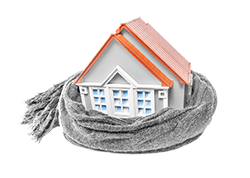Staying warm is not always as simple as cranking the thermostat up. What happens if your furnace dies, or the weather causes an extended power outage during the colder months? Take a look at the following tips to keep warm, and safe!
Staying Warm in an Unheated House
(The following winter heating safety tips are courtesy of the University of Maine Cooperative Extension.)
During severe winter storms, your home heating system could be inoperative for as long as several days. To minimize discomfort and possible health problems during this time, conserve body heat by dressing warmly; find or improvise an alternative heat source, such as a fireplace or electric space heater; confine heating to a single room; and keep safety a foremost consideration. While chances of freezing to death in your home are small, there's a greater danger of death by fire, lack of oxygen or carbon monoxide poisoning.
Think "Safety First"
Safety is critical in a heating emergency. Follow these precautions:
Do not burn anything larger than candles inside your home without providing good ventilation to the outside.
Any type of heater (except electric) should be vented. Connect the stove pipe to a chimney flue if at all possible. (Many older homes have capped pipe thimbles in rooms once heated by stoves.) Or hook up your stove to the flue entrance of the non-functioning furnace pipe. If no other alternative exists consider extending a stove pipe through a window. Replace the window glass with a metal sheet and run the temporary stove pipe through the metal.
If you chose a catalytic or unvented heater, cross-ventilate: open a window an inch on each side of the room. It is better to let in some cold air than to run the risk of carbon monoxide poisoning.
Do not use a gas or electric oven or surface units for heating. A gas oven may go out or not burn well, leading to carbon monoxide poisoning. An electric oven is not designed for space heating.
Do not burn outdoor barbecue materials such as charcoal briquettes inside— even in a fireplace.
Do not try to use bottled gas in natural gas appliances unless you have converted the appliances for such use. Also, flues and piping made for gas-burning appliances may be unsafe for use with higher-temperature oil, coal or wood smoke.
Have one person watch for fire whenever an alternative heat source is used. One person should also stay awake to watch for fire and make sure ventilation is OK. If you feel drowsy or have a headache, it may be a sign of poor ventilation.
All homes should have battery-operated smoke and CO (carbon monoxide) detectors with alarms installed. Check batteries regularly.
Keep firefighting materials on-hand. These include: dry powder fire extinguishers, a tarp or heavy blanket, sand, salt, baking soda, and water.
Conserve Body Heat
Put on extra clothing. If cold is severe, your bed may be the warmest place. Use extra blankets and coverings to trap body heat; this is an especially good way to keep children warm. Farm families might consider taking refuge in a warm livestock barn.
Find or Improvise an Alternative Heat Source
You may have alternative heating resources around your home. Possibilities include:
fireplace, space heater, catalytic camp stove
wood, gas or oil heater
gas-fired hot water heater
Make sure you have a backup plan if you can’t find a safe way to stay warm. Staying with relatives or going to a designated shelter might be an option.
Provide Fuel
Some common materials that could be used for fuel in an emergency include:
firewood, newspapers, magazines
kerosene
wood chips, straw, corncobs
You can burn coal in a fireplace or stove if you make a grate to hold it, and allow air to circulate underneath. "Hardware cloth" screening placed on a standard wood grate will keep coal from falling through. Tightly rolled newspapers and magazines can be used as paper "logs." Stack them as you would firewood to allow for air circulation. If the heating situation becomes critical, consider burning wood, including lumber and furniture.
Select a Room to be Heated
Close off all rooms except the one to be heated. When choosing a room, consider the following:
If you’re using a vented stove or space heater, select a room with a stove or chimney flue.
Confine emergency heat to a small area.
Choose a room on the "warm" side of the house, away from prevailing winds. Avoid rooms with large windows or non-insulated walls. Interior bathrooms probably have the lowest air leakage and heat loss. Your basement may be a warm place in cold weather because the earth acts as insulation and cuts heat loss.
Isolate the room from the rest of the house by keeping doors closed, hanging bedding or heavy drapes over doorways, or putting up temporary partitions of cardboard or plywood.
